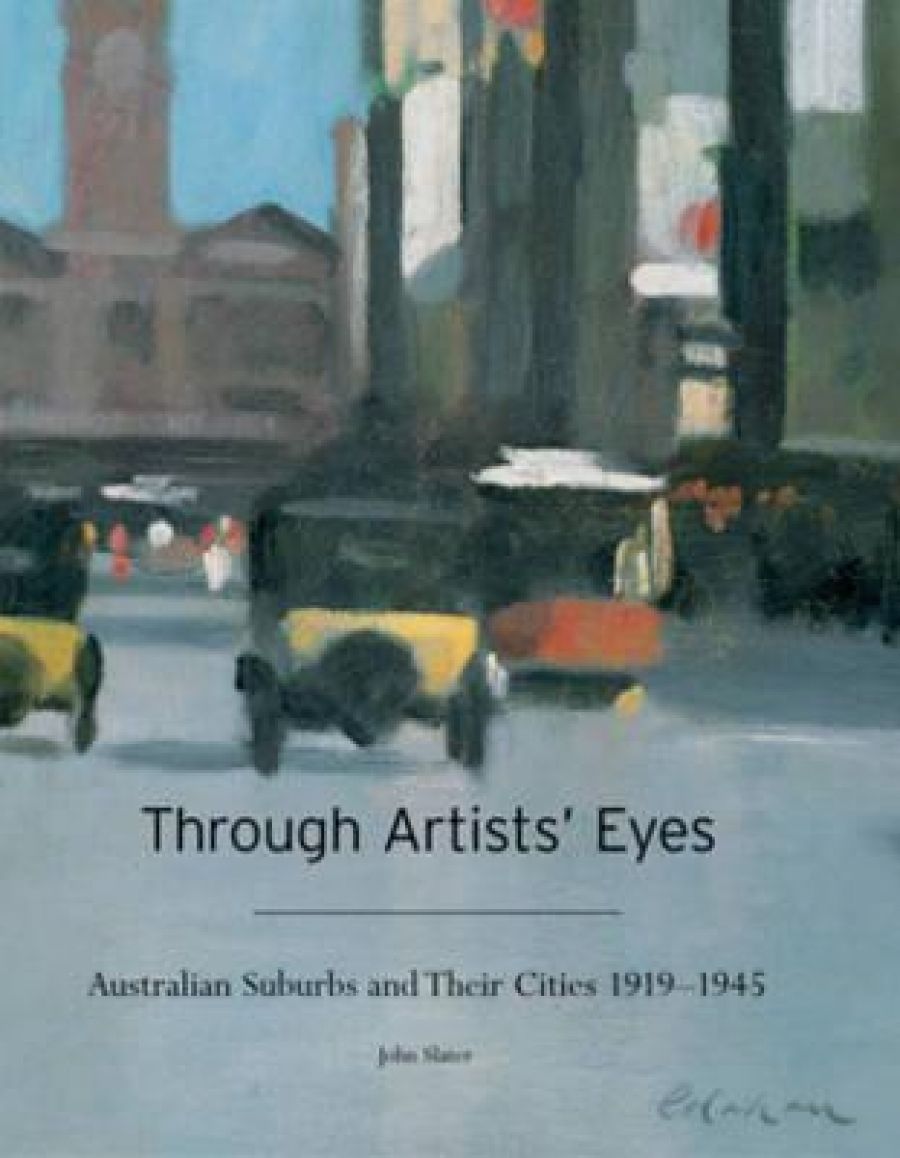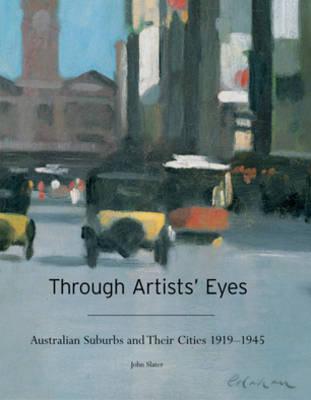
- Free Article: No
- Contents Category: Art
- Review Article: Yes
- Article Title: Bi-hemispheric View
- Online Only: No
- Custom Highlight Text:
The tempting cover leads to a feast of 164 colour pictures, which you will fall upon with delight. Despite the title, almost all are of Melbourne and Sydney, places most Australians know well enough to enjoy pleased shocks of recognition. There are two highly specific Perth roofscapes, but a futurist speeding tram in Adelaide could be anywhere, and so could the industry at Yallourn, or sexual and racial tension at Townsville in 1942. Even if you come from the bush, you will know the city markets, cathedrals, law courts, showgrounds, Circular Quay and Harbour Bridge, Flinders Street Station and Collins Street trams, Town Hall concerts, Tivoli showgirls, Manly, St Kilda, racy Kings Cross lats, a frisson of ‘slums’. The author says he chose the works of art solely for their subject matter, yet he certainly appreciates aesthetic force. It’s a lively anthology of transport and other social nodes, parklands, beaches, building construction, shopping, entertainment. It makes the familiar look unexpectedly interesting.
- Book 1 Title: Through Artists’ Eyes
- Book 1 Subtitle: Australian Suburbs and their Cities, 1919-1945
- Book 1 Biblio: Miegunyah Press, $69.95 hb, 238 pp
- Book 1 Cover Small (400 x 600):

- Book 1 Cover (800 x 1200):

These paintings – and etchings, woodcuts, linocuts and photographs – of modern urban living were rather under the radar of their time. It was a period in which official and public taste was anti-modern and preferred paintings of the bush, the wool-growing Land of the Golden Fleece that produced most of the country’s wealth. Ian Burn’s National Life & Landscapes: Australian Painting 1900–1940 (1991) discussed some of the same unselfconscious modernity by way of contrast with the conservative, nationalistic blue-and-gold bush landscapes.
John Slater is an Englishman who fell in love with Australia at Art Monthly editor Peter Townsend’s salon in a Soho pub. Slater became bi-hemispheric, spent seven years trawling our libraries and collections, and produced a doctoral thesis for the University of Exeter. It’s a better result than many thesis-based books, but for those who decide to read the text as well as browse the pictures, the biggest irritation will be the references to, and full descriptions of, pictures that are not illustrated here. It’s a bit of a slog to read about the absentees. It’s also extremely irritating to have to hunt the text for dates of the strangely under-captioned pictures, and then the picture list for their whereabouts. Browsers expect dates and owners: when did motor cars have the square Mondrian-on-wheels look of Colin Colahan’s Melbourne street scene (1936); where is the original (Ballarat Fine Art Gallery).
The title contains a false promise. Only the last of ten chapters is about residential suburbia. So you still need to know about Chris McAuliffe’s shorter and less splendidly illustrated Art and Suburbia (1996), which begins in the 1880s, though it is mostly post-1945 and therefore includes the John Brack interior The new house (1953). Cultural theorist McAuliffe goes to town on a ‘locus of feminine activities; repository of consumer goods … a siren song of suburbia emasculating the husband, and by extension, the nation’. We will miss the entertaining giddiness of postmodern theory. Slater instead finds many works by women artists, and statements by 1920s and 1930s women writers, that take for granted the charms of suburbia.
The economist-philosopher Hugh Stretton’s Ideas for Australia’s Cities (1970) gets a nod from McAuliffe, though it escaped Slater. Stretton made a case for our leafy suburbia as one of Australia’s great national achievements. Only about ten of Slater’s images are leafy-suburban, and only two truly paradisal: Streeton’s weakish tea in a Toorak back garden; Cossington Smith’s powerful fragment of tennis lawn, flowers and European blossom trees beneath surging cubist eucalypts at Turramurra.
Slater’s text is an amazing accumulation of significant detail. For example, Perceval’s Negroes at night (1944) is Melbourne during wartime ‘brown-out’, distant factory chimneys, a train crossing the Yarra to foreground suburbia and a circular drying-hoist with laundry and another, which you could miss, with a broken body on it; a disembodied black Fats Waller face oversees the wild white GI dancers. Slater finds interesting comments, often in The Bulletin, made when his chosen pictures first appeared. We learn that Colin Colahan had a specially designed Chevrolet van with a skylight, a mobile studio to park in the city centre and paint ‘the traffic-torn metropolis’. Dora Wilson was ‘sitting in a motor car with an easel in front of her’ painting the boring beige impressionist street scenes, now forgotten, that in their day were among the highest priced canvases in Australia.
The publisher has done Slater proud with so many excellent colour pictures (though those from the Art Gallery of New South Wales are all muddy), but not with the editing. Besides the strange picture captions, the non-text matter betrays unfamiliarity with art-book conventions and the Australian scene. Obsolete gallery names occur, places are misspelt (‘Woolongong’); artists’ names vary, get reversed or are wrong (‘Evelyn’ Syme should be Eveline) and thanks go awry to curator ‘Terrence’ Lane, and to Dame ‘Elizabeth’ Murdoch. Dame Elisabeth helped pay the considerable cost of the illustrations.


Comments powered by CComment